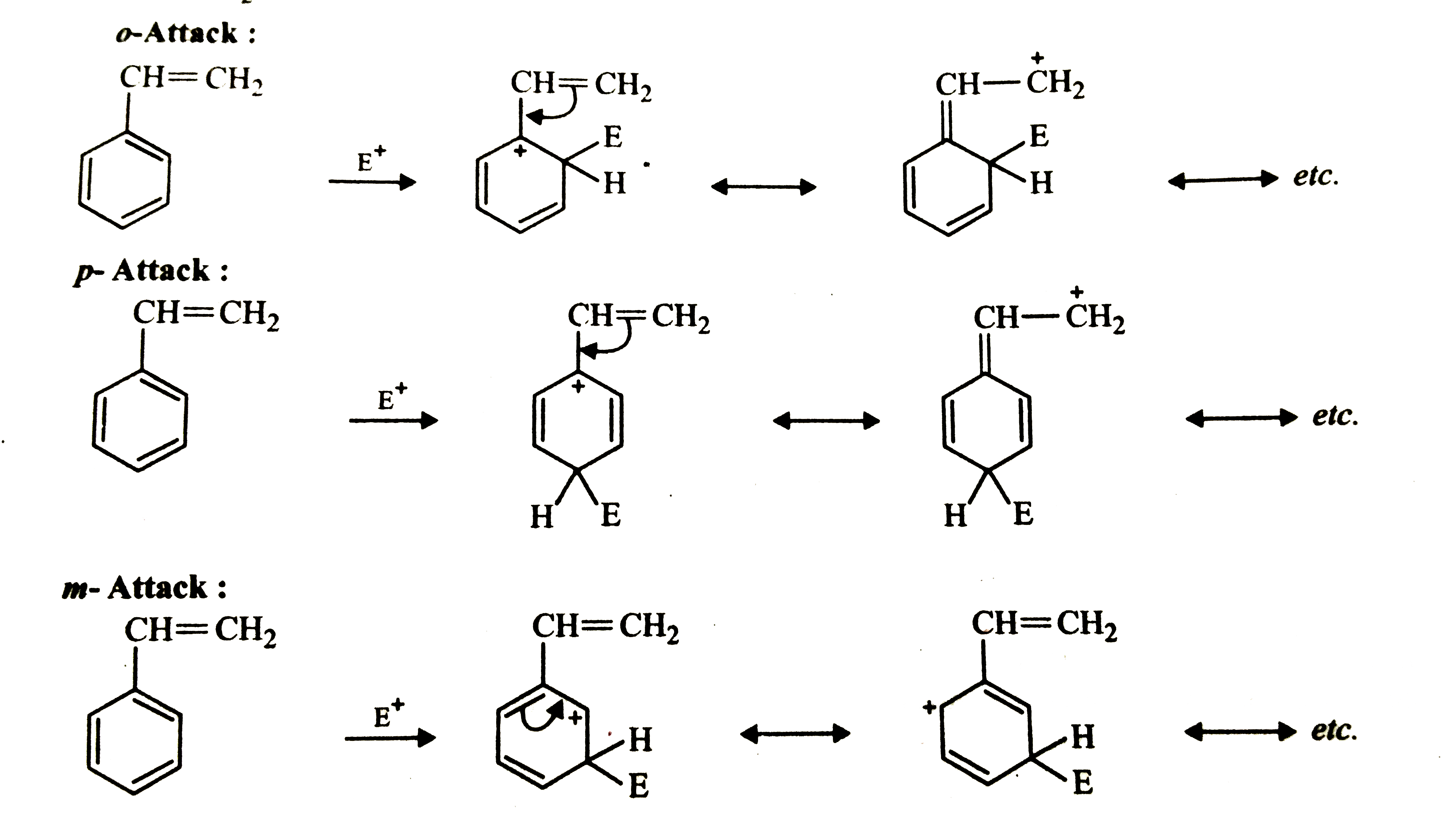How will you explain the directive influence of
(i)−CH=CH2 and (ii) −CCl3 group when attached to the benzene ring ?
(i)Stability of the carbocation intermediate can be used to explain the o,p-directing influence of the −CH=CH2 as follows :

Only carbocations resulting from o- and p-substitution are stabilized by spreading the charge on the side chain while each such type of stabilization is not possible in case of m-substitution. Thus, −CH=CH2 group is o,p-directing . Similarly, we can explain the directive influence of C6H5 group which is also o,p-directing.
(ii)Hyperconjugation effect can be used to explain the directive influence of CCl3 group as discussed below .

Due to the presence of +ve charge at o- and p-positions , the electron density is comparatively more at m-positions. Therefore , −CCl3 is a m-directing group.
Topper's Solved these Questions
- BOOK - PRADEEPCHAPTER - HYDROCARBONSEXERCISE - NCERT QUESTION AND EXERCISES WITH ANSWERS14videos
HYDROCARBONS
- BOOK - PRADEEPCHAPTER - HYDROCARBONSEXERCISE - NCERT QUESTION AND EXERCISES WITH ANSWERS (NCERT EXCERCISES)25videos
HYDROCARBONS
- BOOK - PRADEEPCHAPTER - HYDROCARBONSEXERCISE - TEST YOUR GRIP (FILL IN THE BLANKS )20videos
HYDROCARBONS
- BOOK - PRADEEPCHAPTER - EQUILIBRIUM IN PHYSICAL AND CHEMICAL PROCESSESEXERCISE - Competition Focus (Jee(Main and advanced)/Medical Entrance) VIII. ASSERTION - REASON TYPE QUESTIONS (TYPE - II)10videos
EQUILIBRIUM IN PHYSICAL AND CHEMICAL PROCESSES
- BOOK - PRADEEPCHAPTER - HYDROGEN EXERCISE - COMPETITION FOCUS (Assertion-Reason Type Questions) Type 215videos
HYDROGEN
Similar Questions
Knowledge Check
- Question 1 - Select One
The directive influence shown by CI3 group attached in benzene ring is
Am- directingBo and p - directingCdue to - I effect onlyDdue to hyperconjugation - Question 2 - Select One
The increasing order of hyperconjugative effect of CH3−,C2H5−,(CH3)2CH− and (CH3)3C− when one of these is attached to benzene ring is
ACH3,C2H5,(CH3)2CH and (CH3)3CB(CH3)3C,(CH2)CH,CH3,C2H5C(CH2)2CH,(CH3),CH3C2H5DNone of the above - Question 3 - Select One
Consider the following statements
I.The-OH group present in the phenol is ortho and para directing
II.Directive influence of a functional group in monosubstituted benzene depends on the nature of the substituent already present in the benzene ring.
III.The -OH group activates the benzene ring for the attack by an electrophile
Select the correct option.AI and IIBII and IIICII,III,IVDAll of the above
Predict the nature of the M−effect when 'Cl' and 'NO2' groups are attached to the benzene ring. Write the different resonating structures.
View SolutionThe trichloromethyl group is meta directing when attached in benzene ring due to
View SolutionConsider the following statements,
I. The -OH group present in the phenol is ortho and para-directing .
II. Directive influence of a fundamental group in monosubstituted benzene depends on the nature of the substituent already present in the benzene ring.
III. The -OH group activates the benzene ring for the attack by an electrophile.
IV. Groups such as −NH2,−NHR,−NHCOCH3,−OCH3,−CH3,−C2H5., etc, are the examples of activating group.
Selection the correct option.View SolutionAssertion : When the alkyl group is small like −CH3 group, there is n steric hindrance to H-bonding.
Reason (R) : In aniline or other arylamines, the −NH2 group is attached directly to the benzene ring.View SolutionWhen −N+CH3 group is attached to the benzene ring, it directs the incoming electrophile into
View Solution
